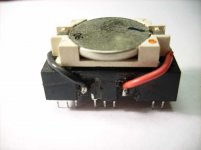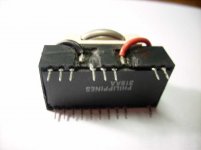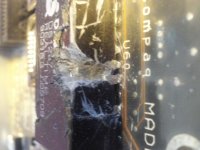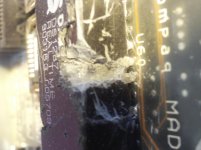As for risk...depends on soldering/desoldering skill, vs hand tool skill and control. I think the majority of people will find it much easier to burn PCB traces beyond repair than to hit the board with the saw hard enough to break traces...since I have tried to intentionally break traces in some situations and found them far more resilient than to be damaged by a single, accidental-force impact.
Here is the first one I did, way back when, the one that punctured my finger. I realize neither the camera pic or the flatbed scan are perfect, but it gives you another reference point to work from (they all look the same, but hey, maybe it'll help)
Note that the composition of this module is a DIP chip with stuff piled on top of it inside. Generally, then, the best place to try to make contact with the upwards-bent pins is as far down the side as possible. With a soldered-in module, this does get difficult...it would be important to make sure you don't break the pin off the side of the IC itself, or it's junk.
Also hot glue works well to stick the socket on top. And yes, those are seriously bad solder joints, but they work. This module is still working after I hacked it up a couple years ago, same battery, and if I pop it into my Model 30 286 it will not throw an error about configuration lost/dead battery etc because it is holding the settings still. That machine contains another hacked module currently, IIRC.







